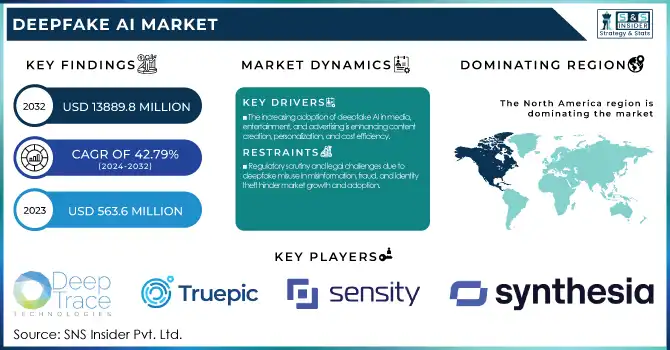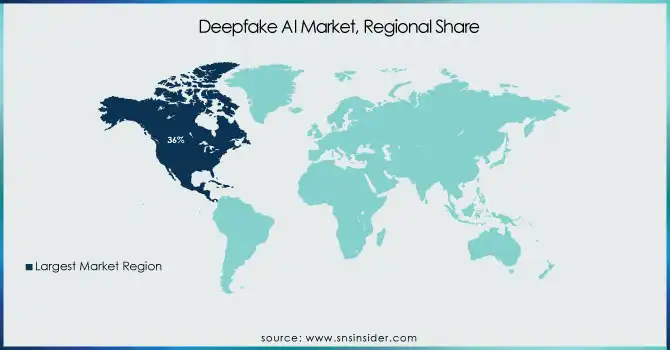Deepfake AI Market Report Scope & Overview:
The Deepfake AI Market was valued at USD 563.6 Million in 2023 and is expected to reach USD 13889.8 Million by 2032, growing at a CAGR of 42.79% from 2024-2032.

To Get more information on Deepfake AI Market - Request Free Sample Report
The Deepfake AI Market saw rising adoption trends in 2023, with increased use in media, entertainment, and cybersecurity. User demographics indicate growing adoption across industries like social media, law enforcement, and digital marketing. While detection & prevention capabilities are evolving with AI-powered tools, deepfakes remain a challenge for authenticity verification. The impact on cybersecurity & misinformation is significant, driving concerns around identity fraud, political manipulation, and fake news. The report also explores regulatory developments, ethical AI advancements, and the rise of deepfake-as-a-service platforms, shaping the market’s future.
Deepfake AI Market Dynamics
Driver
-
The increasing adoption of deepfake AI in media, entertainment, and advertising is enhancing content creation, personalization, and cost efficiency.
Increasing use of deepfake AI in the media & entertainment sector is one of the major factors driving the market growth. Deepfakes are widely used by content creators, filmmakers, and advertisers to enhance their videos with visual effects, dubbing, and hyper-realistic animations. This technology will take storytelling to another level, reduce production costs and create customized content. Also, the entertainment industry uses deepfakes to digitally clone actors, change facial expressions and produce lip-syncing in various languages into films. Social media and streaming platforms are also using AI personas with high-quality voiceovers for immersive content. The ever-increasing demand for immersive, interactive media experience is driving the deepfake AI market; but this spur further new business opportunities and innovations.
Restraints
-
Regulatory scrutiny and legal challenges due to deepfake misuse in misinformation, fraud, and identity theft hinder market growth and adoption.
The malicious use of deepfake AI for misinformation, identity theft, and cyber fraud, will act as a major market growth restraint. Because of the potential to spread false narratives, manipulate elections, and impersonate people, deepfake applications are under more scrutiny by governments and regulatory bodies. Legal systems fail to establish baselines of risks: the absence of clear global regulations only adds to the complexity of the market. If the AI-generated content is linked to unethical or misleading practices, then it can put the reputation of the business at risk. Therefore, businesses are dealing with stringent regulations while having to balance between ethical use of AI, which is hindering mass adoption in industries that fear legal liabilities.
Opportunities
-
The demand for AI-driven deepfake detection solutions is rising, driving innovation in cybersecurity, digital forensics, and content verification.
Deepfakes pose growing threats and potential adversarial use cases to detections of forged media, creating compelling market spaces for countermeasures. Various tech companies and cybersecurity firms are creating complex algorithms based on ML, Blockchain, and facial recognition to detect deepfakes. They are crucial for social media platforms, financial institutions, and law enforcement agencies to detect and stop creating fraudulent content. Also, with the help of AI ethics initiatives, regulatory compliance tools are on the rise to help businesses adopt deepfake technology while finding a balance between mitigating risks and acting responsibly. This rising need across sectors such as digital forensics, media and identity protection is driving the continued innovation and investment in deepfake detection, creating a complementary market for AI security solutions.
Challenges
-
The growing sophistication of deepfake AI makes detection difficult, posing risks to security, media integrity, and regulatory enforcement.
Deepfakes use AI to create counterfeit content that is becoming increasingly difficult for businesses and regulators to identify, thanks to the rapid development of the underlying technology. Improvements in generative adversarial networks have made deepfake videos, pictures, and vocal clones almost indistinguishable from real content. This makes it harder for cybersecurity companies, media organizations, and law enforcement to detect whether content has been manipulated. Also, the increase of open-source deepfake tools creates a big opportunity for threat actors to produce and disseminate fake content. Combating this challenge will continue to take investment in AI detection technologies, digital watermarking, and law enforcement, but the increasing sophistication of deepfake AI is an ongoing challenge to the market.
Deepfake AI Market Segmentation Analysis
By Component
In 2023, the software segment dominated the market and accounted for significant revenue share. Growth of the synthetic media platforms is enhancing the landscape of the Deepfake AI software segment. Through such platforms, people create and share synthetic content for entertainment, marketing, education, and a wider range of other industries. These platforms also democratize the use of deepfake and AI technology, allowing more creators to create more deepfaked content with which people can also engage with and personalize.
Organizations are hiring professional & managed services for these technologies. Professional services can provide consulting, training and integration support to help businesses understand the vital aspects of deploying deepfake AI solutions.
By Type
In 2023, the image deepfake segment dominated the market and accounted for a significant revenue share. The image-deepfake part is growing from the media and entertainment industry into several fields including healthcare, education, and retail. For healthcare, image deepfakes can serve virtual consultations and training simulations, creating realistic experiences for medical professionals. In education, by making lifelike reenactments and visualizations.
The video deepfake segment is expected to register the fastest CAGR during the forecast period. it is being used more and more in entertainment and marketing to create entertaining but tailored content. Businesses have been using deepfake AI technology for creating life-like character animations, special effects, and even customized ads for niche audiences. Its credible production processes ensure not only viewership retention with innovation but also slashes cost burden as compared to traditional filming methodologies.
By Technology
In 2023, the GANs segment dominated the market and accounted for significant revenue share. As the demand for high-quality synthetic media has increased, so has research on GANs — generative adversarial networks, the backbone of deepfakes. Currently, GAN algorithmic programs have made strides in developing content that closely resembles real human expressions, movements, and voice features.
Demand for quality synthetic media opens door for transformative models in deepfake AI market. Transformer architectures capable of generating realistic and contextually relevant text or even images, are now a crucial part of everything from entertainment to marketing to education. This particular feature makes them capable of rendering high-fidelity audio & visual elements, which improves the overall achievement of the deepfakes, and so they are used by many.
By Vertical
In 2023, the media & entertainment segment dominated the market and accounted for significant revenue share. And as the level of demand for high-quality, entertaining content increases, media producers and entertainment organizations alike are turning to deepfake AI technology to offer new forms of audio-visual experiences. By reproducing the likenesses of celebrities, historical figures and fictional characters, generative AI tools take storytelling to a whole new level by making the viewer more engaged.
The BFSI segment is expected to register the fastest CAGR during the forecast period, Deepfake technology certainly offers considerable benefits for the BFSI industry while presenting an equally perilous threat with its double-edged nature. For instance, sophisticated fraud schemes based on deepfakes have increasingly been observed also in identity theft and in opening or executing transactions with impersonated accounts. For example, one high-profile case involved a Hong Kong company in which an employee was fooled into sending USD 25 million after a video call with a deepfake of the real CEO.
Regional Landscape
North America dominated the market and accounted for 36% of revenue share. North American regulatory and ethical frameworks are being positioned as deepfake AI technology proliferates. Deepfakes have also caused problems for governments and regulatory bodies, which are starting to find ways to regulate them in issues around privacy, misinformation, and consumer protection.
Asia-Pacific segment is expected to register the fastest CAGR during the forecast period, due to Rapid technological advancements and growing consumption of digital media. In countries like China, Japan, and India, deepfake AI technology is already being used for entertainment, advertising, and educational purposes.

Get Customized Report as per Your Business Requirement - Enquiry Now
Key Players
The major key players along with their products are
-
Deeptrace – Deepfake Detection Platform
-
Truepic – Truepic Lens
-
Sensity AI – Sensity Deepfake Detection API
-
DeepMedia – AI Voice & Video Translation
-
Synthesia – AI Video Generator
-
Colossyan – Colossyan Creator
-
Hour One – AI Virtual Human Platform
-
Reface AI – Reface App
-
Zao – Zao Deepfake App
-
MyHeritage – Deep Nostalgia
-
Pinscreen – AI-Generated 3D Avatars
-
D-ID – Creative Reality Studio
-
FaceSwap – FaceSwap Open-Source Software
-
Avatarify – AI-Powered Face Animation
-
Modulate AI – ToxMod Voice Moderation AI
Recent Developments
-
July 2024: Trend Micro introduced new innovations in its enterprise platform and consumer cybersecurity products focused on protecting all environments from the rapidly growing threat of AI-based attacks and fraud.
|
Report Attributes |
Details |
|
Market Size in 2023 |
USD 563.6 Million |
|
Market Size by 2032 |
USD 13889.8 Million |
|
CAGR |
CAGR of 42.79% From 2024 to 2032 |
|
Base Year |
2023 |
|
Forecast Period |
2024-2032 |
|
Historical Data |
2020-2022 |
|
Report Scope & Coverage |
Market Size, Segments Analysis, Competitive Landscape, Regional Analysis, DROC & SWOT Analysis, Forecast Outlook |
|
Key Segments |
• By Component (Software, Service) |
|
Regional Analysis/Coverage |
North America (US, Canada, Mexico), Europe (Eastern Europe [Poland, Romania, Hungary, Turkey, Rest of Eastern Europe] Western Europe] Germany, France, UK, Italy, Spain, Netherlands, Switzerland, Austria, Rest of Western Europe]), Asia Pacific (China, India, Japan, South Korea, Vietnam, Singapore, Australia, Rest of Asia Pacific), Middle East & Africa (Middle East [UAE, Egypt, Saudi Arabia, Qatar, Rest of Middle East], Africa [Nigeria, South Africa, Rest of Africa], Latin America (Brazil, Argentina, Colombia, Rest of Latin America) |
|
Company Profiles |
Deeptrace, Truepic, Sensity AI, DeepMedia, Synthesia, Colossyan, Hour One, Reface AI, Zao, MyHeritage, Pinscreen, D-ID, FaceSwap, Avatarify, Modulate AI |

